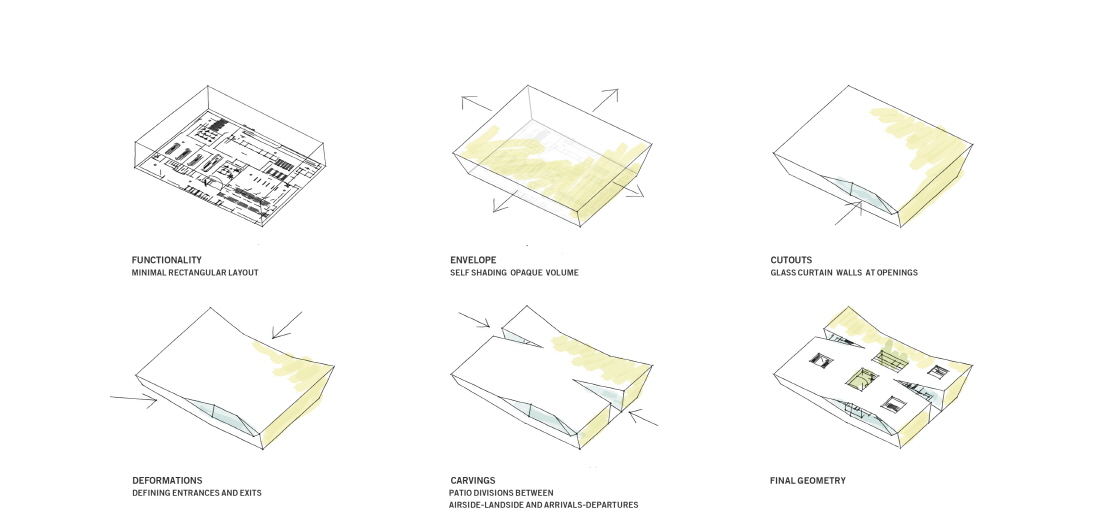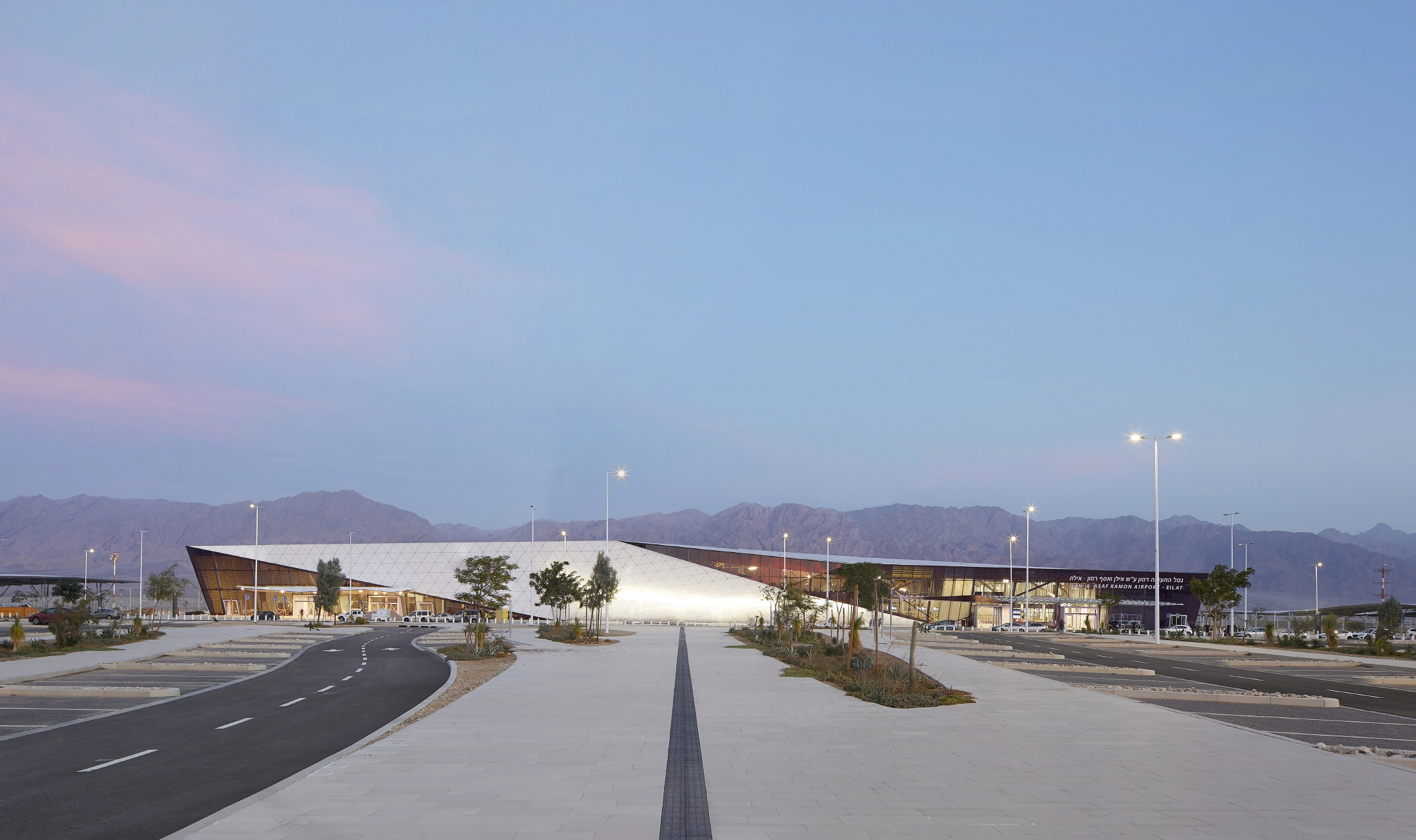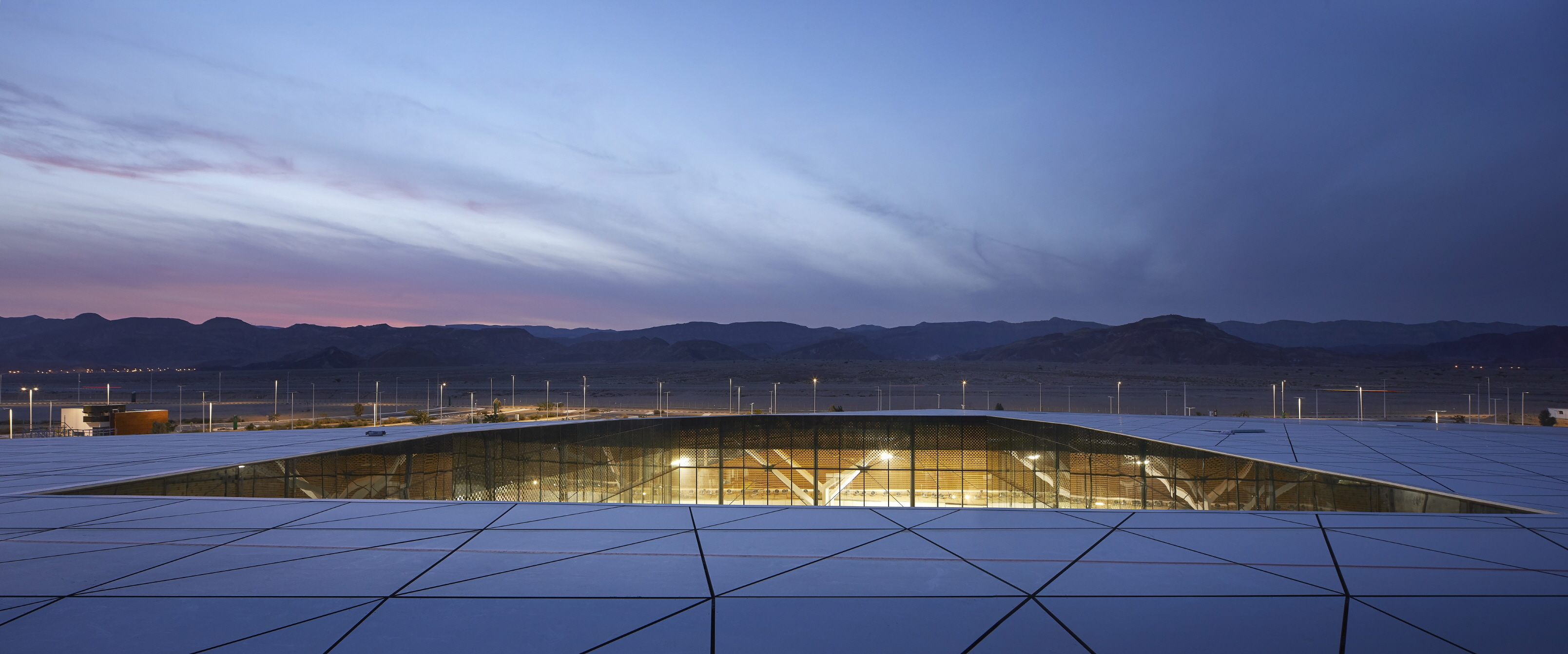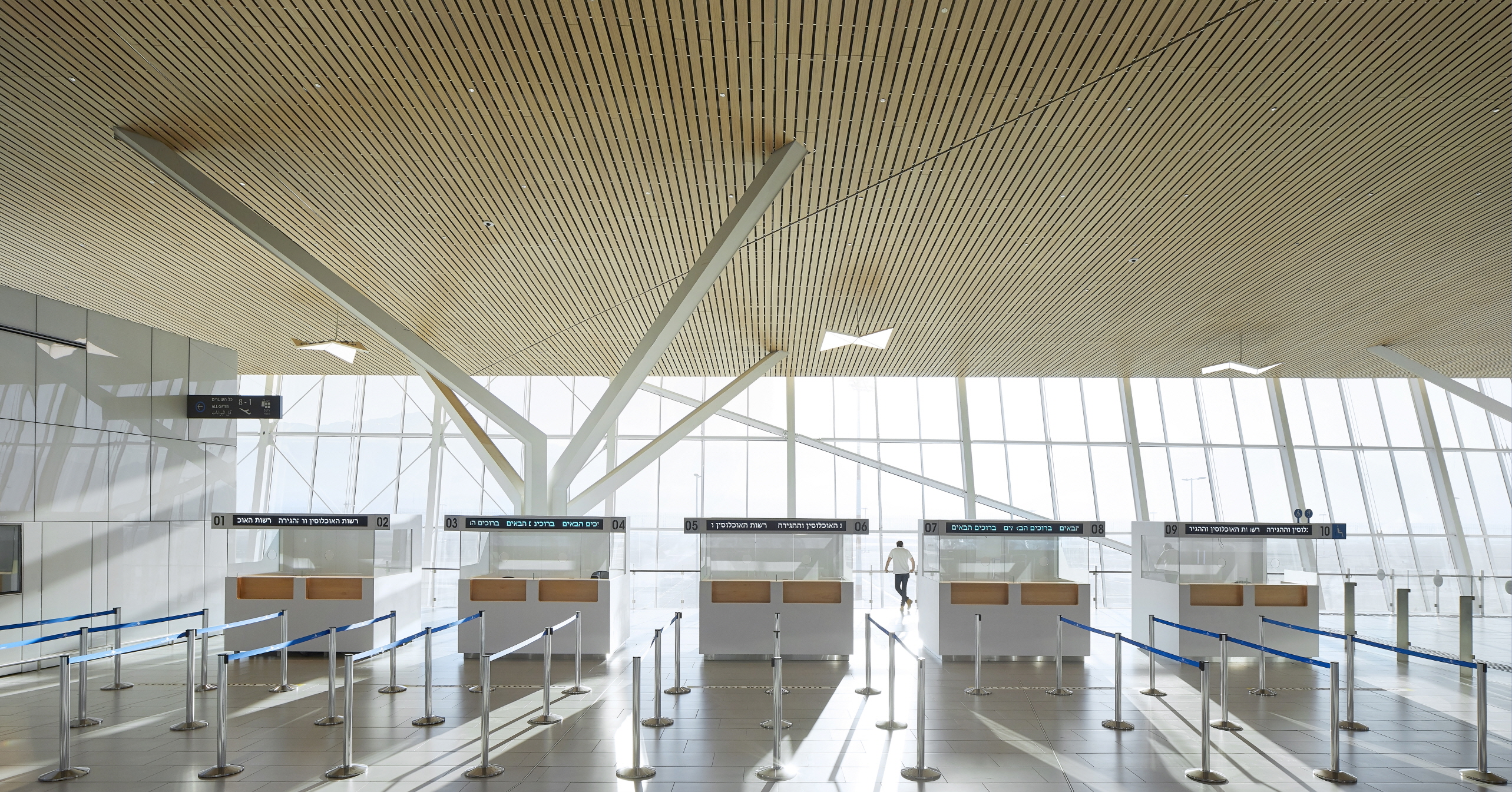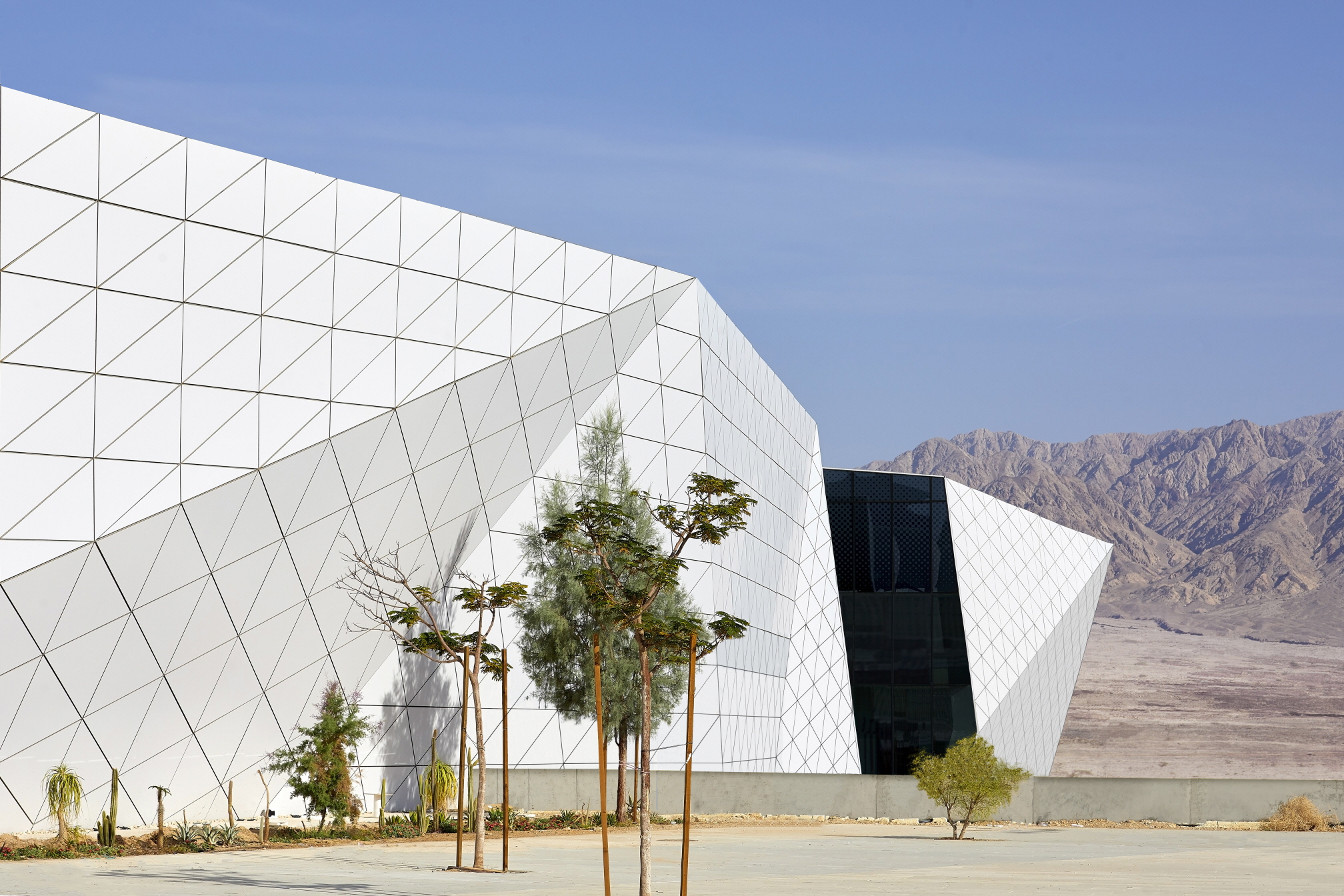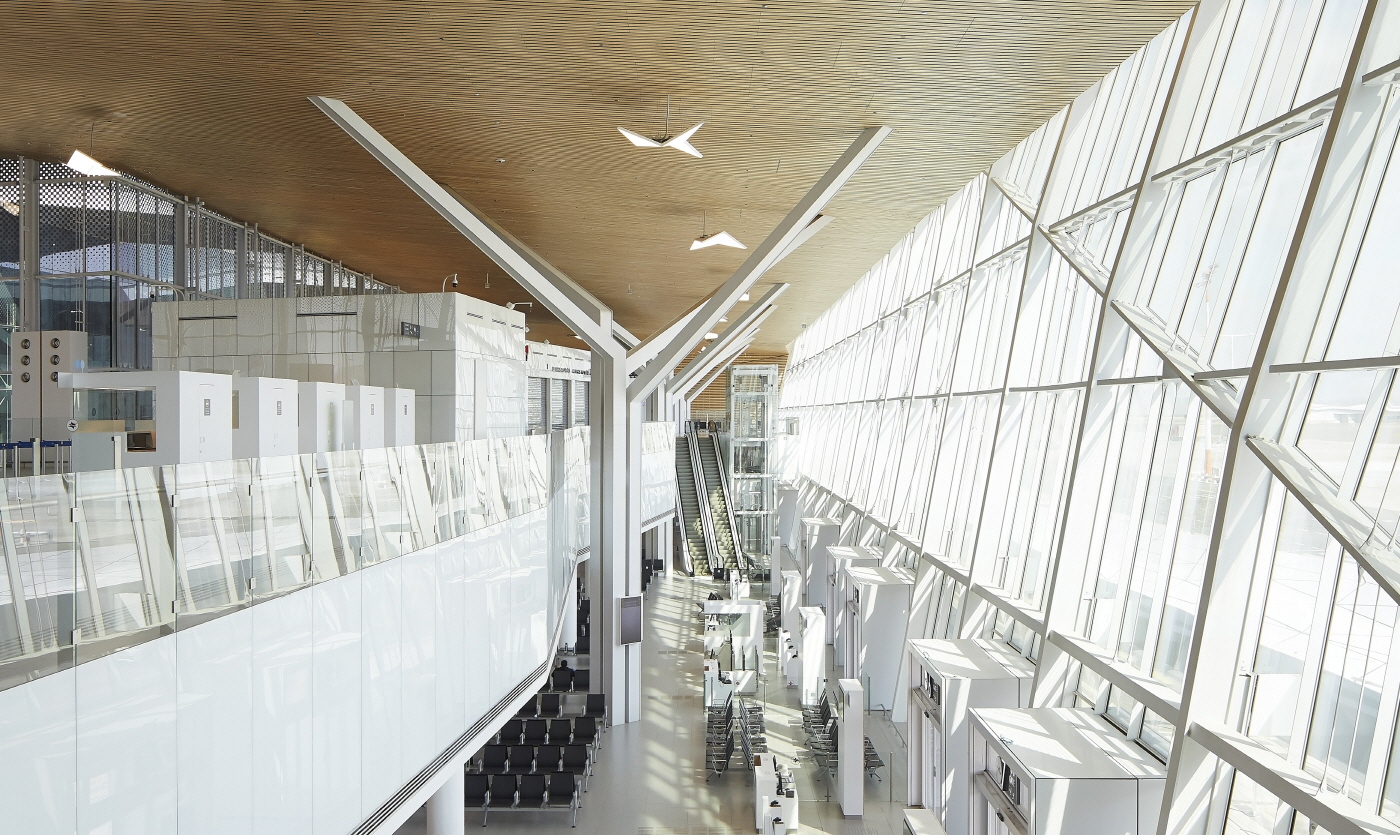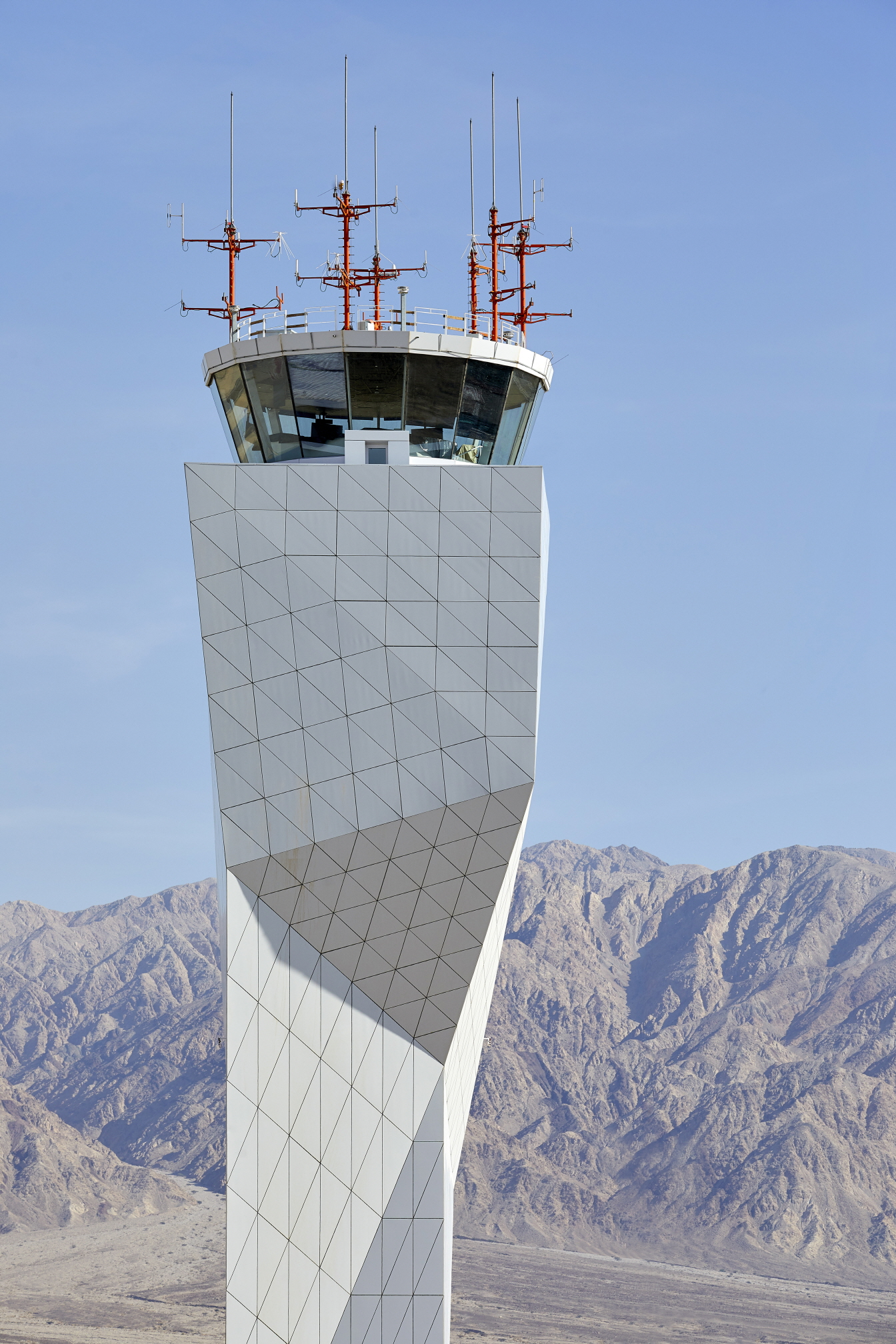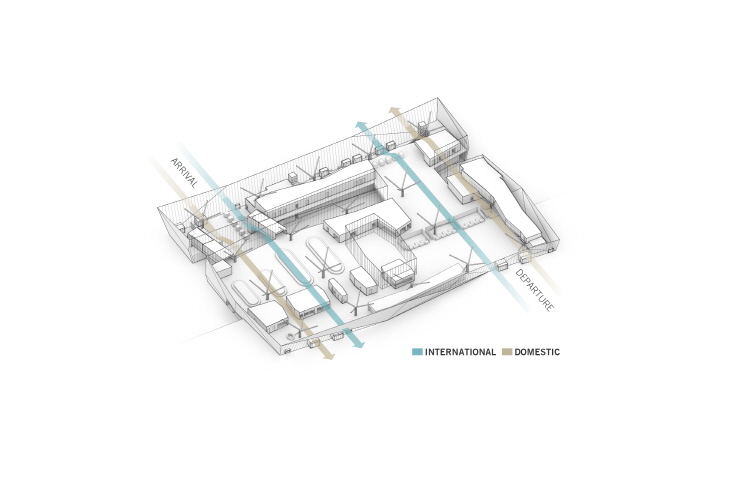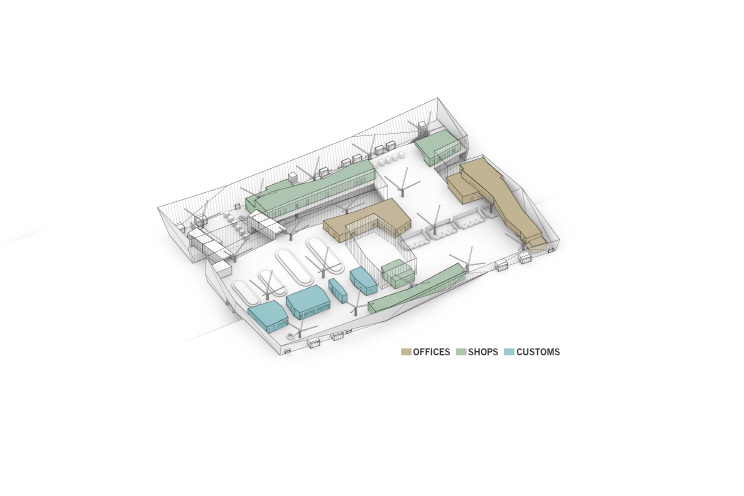AD
●● 멋진 세상 속 건축디자인_ 네게브사막 위에 신기루처럼 등장한 이스라엘 최남단 관문 ‘일란 아사프 라몬 국제공항(The Ilan and Asaf Ramon International Airport, Israel)’… 팀나국립공원의 버섯 모양 암석과 산과 계곡의 삼각주 지형적 흔적을 공항터미널 건축과 조경에 효과적으로 적용해
올 1월 21일에 개장한 일란 아사프 라몬 국제공항의 명칭은 2003년 미국 우주왕복선 컬럼비아호의 폭발 사고로 사망한 이스라엘 최초의 우주비행사인 일란 라몬과 그의 아들이자 이스라엘 공군조종사였던 아사프 라몬의 이름을 딴 것이다. 전투기 조종사 출신의 일란 라몬은 이스라엘 초초의 우주비행사였으며 중동전에서 큰 공을 세운 이스라엘의 영웅이었다. 그가 컬럼비아호를 탑승할 때 유대인의 경전 토라를 지니고 탑승한 것으로 유명하다. 아들 아사프 라몬 역시 공군조종사 과정을 이수하고 전투기를 몰며 비행훈련을 하던 중 전투기가 팔레스타인 서안 지역의 언덕에 충돌하여 사망했다. 이들 부자의 국민영웅으로 추대 받았고 국제공항의 이름으로 아로 새겨지게 된 것이다.
The country's newest airport is a futuristic desert mirage built into the timeless natural surrounding and becomes the new Southern gate to Israel by the Red Sea Exterior view of the Ilan and Asaf Ramon International Airport Timna, Israel: Amir Mann-Ami Shinar Architects and Planners in partnership with Moshe Zur Architects, two of Israel's leading firms, announce the opening of Israel's Ilan and Asaf Ramon International Airport, servicing the Red Sea resort city of Eilat and surrounding region. Commissioned by the Israel Airport Authority(IAA), the project was handled from A to Z by design manager, Architect Amir Mann. Located in Timna, it is Israel's first civil airport built from scratch("greenfield").
Spread across 1,250 acres, the airport is a minimalist and futuristic design in the middle of the Negev Desert, wholly unified under one architectural language. The architects served as project design managers, leading more than 45 consulting firms, nearly all local Israeli engineers, alongside ARUP London's aviation team. Situated just 18 KM north of Eilat, the Ilan and Asaf Ramon International Airport will become a major game changer for local and international tourism to Israel, Jordan and Egypt's Sinai Desert.
The Ilan and Asaf Ramon International Airport was completed with significant achievements, firstly, an international airport fully constructed and operational within budget, funded for less than half of similar projects worldwide; on schedule for opening day within an exceptionally tight timeframe; a "greenfield" without existing infrastructures, included the creation and implementation of cutting edge navigation, landing, and baggage handling systems, runways, and operational buildings - while maintaining the existing natural surrounding and a control of quality; all led by the team of architects to a rather extraordinary feat - the entire airport is unified under one unique holistic design language that frames the stunning scenery of the Negev Desert mountainscape.
The Airport features a 45,000 square-meters Passenger Terminal Building and 3,600 meters long runway and taxiway, alongside 40 aprons, allowing for domestic and international traffic. The two support structures to the north and south of the terminal measure a combined 36,210 square-meters with a 45 meters-high Air Control Tower.
The opening of the Ilan and Asaf Ramon International Airport will coincide with the closing of the existing J. Hozman Eilat Airport that is currently located in the middle of the city of Eilat. The old airport was a barrier within the city, dividing and disrupting its development. With its annulment, the city's urban fabric will be able to unite, surfacing potential opportunities and regeneration. The Ilan and Asaf Ramon International Airport will serve as the new southern gate to Israel and is expected to host 2.25 million passengers per year, that figure bound to grow to an estimated 4.25 million passengers per year.
For the project, the architects developed a unique and minimal design language influenced by the futuristic world of aviation and its seemingly timeless natural desert surrounding. The decision of the IAA to appoint the architects as design managers responsible for budget, program, and planning schedule, allowed for the architects to implement the design across the entire airport - from the various buildings to each individual check-in counter, thus unifying the airport on all its parts into a holistic singular entity within the dramatic emptiness of its surrounding. This is evident from a general concept of carved geometries, through a limited choice of materials used to clad the family of forms.
"In designing the airport we learned from the desert scenery. It required a vision of the most suitable design solution that responds to the existing landscape and climate. Our objective was how not to compete with the overwhelming emptiness of the site, while creating a place that welcomes passengers through the departure and arrival processes, reflecting through that experience the uniqueness of the desert environment, as a functioning international southern gate to Israel." - Project Design Manager, Amir Mann.
The mushroom-like rock formations found in Israel's National Timna Park served as inspiration for the initial geometry of the Passenger Terminal Building as a self-shading volume. Just as the rocks are shaped by the "natural movements" of wind and water, the terminal's opaque volume was carved by the "natural movements" of the passenger traffic: at the entrances and exits, at the divisions between arrivals and departures, and between the check-in and boarding gate halls. At every such occasion glass curtain walls were inserted, surrounding patios that introduce the natural desert landscaping into the building. These serve as light wells allowing natural light into the depths of the terminal, instead of the commonly used skylights, impossible within such climate conditions.
The terminal's envelope consists of a steel and concrete skeleton structure, cladded to the exterior with insulating aluminum triangular panels, continuous from wall to roof that create one single mass. The pristine white panels reflect the light rays and the UV waves and thus help in further reducing the skin's temperature. Towards the interior, the building's volume is hollowed out and the envelope is cladded in a contrasting bamboo-wood, uniting the ceiling and walls over one continuous space.
The terminal building's minimalist interior scheme is based on a tightly organized high-ceilinged hall with low-level furniture and pavilions acting as dividers. Its entire infrastructure including baggage handling, security processes, and many other technical operations and systems are all hidden on a lower level. This allows for the roof to be free of any technical equipment as a fifth façade viewed from the airplane window, and for all passenger processes to be efficiently on one single level. The result being a "Miesian" - like terminal hall where all passenger traffic is viewable, separated only by the desert patios. The terminal opens at the boarding gate area with a 20 meter high glass curtain wall towards the theatre of aviation with the desert view as a backdrop.
The landscape design development drew inspiration from the existing river delta fan created by the mountain flooding into the desert valley. Thus, the delicately winding paths of the parking lot and the landscape development follow the shape of the natural spill from the streams. As part of the aspiration to preserve and integrate the landscape with the environment, and with the intention of maximizing the use of existing local materials, all the sand and rock infrastructure excavated at the site was used as a filler for the construction of the runways, the airplane hardstands, and the roads. To this end, a grinding factory was set up to crush the pebbles into bedding materials. The land collected during dig was also used to finally cover the ground upon completion of construction to seamlessly integrate the landscape development with the natural surrounding. In addition, local plant seeds were harvested and preserved at the site, grown and incubated in greenhouses during the years of construction, and finally returned to their original location, to serve as the desert vegetation lining the airport's landscape.
1250 에이커에 걸쳐 신비롭게 펼쳐진 일란 아사프 라몬 국제공항은 사막의 척박한 자연 환경을 기반으로 사막의 신기루처럼 세워진 커다란 흰색 비정형의 매스를 한껏 드러내고 있다. 공항이 들어선 위치가 주변 요르단 국가와 국경이 불과 800m 떨어져 있어 사뭇 긴장감을 형성하게 만들지만, 그 날렵한 미래지향적인 건축 매스는 홍해로 가는 이스라엘의 남문으로서 튼실한 자격을 지닌다. 개장 이후 공항 측은 연간 225만 명의 승객을 수용하며, 향후 연간 약 420만 명의 승객이 이용할 것으로 예상하며 지속적인 성장세를 이어가고 있다. >>Design Management_ Amir Mann, Architect/ Amir Mann–Moshe Zur–Ami Shinar–Orna Zur Architects, 자료_ Amir Mann-Ami Shinar Architects and Planners, Moshe Zur Architects, Photos by Hufton + Crow, 기사 출처_ 에이앤뉴스 AN NEWS(ANN 뉴스센터) 제공
안정원(비비안안 Vivian AN) 에이앤뉴스 ANN 발행인 겸 대표이사, 한양대학교 실내건축디자인학과 겸임교수, 한양대학교 IAB자문교수
Israel Airports Authority: Israel Airports Authority(IAA) Yaacov Ganot Directing Manager, Rafi Elbaz Deputy Director General Engineering & Planning Division
Design Management: Amir Mann, Architect/ Amir Mann–Moshe Zur–Ami Shinar – Orna Zur Architects
Construction Management: Ron Havazelet, Gadish-Baran Partnership
Aviation: ARUP
BHS/HBS Systems: Case Technologies/ARUP
Structure, MEP Engineering: Local Israeli teams
Estimated construction cost: 450 million$
Estimated terminal construction cost: 60 million$
Terminal Floor Area: Approx. 35,000sqm
Total Building Area: Approx. 92,000sqm
Total site Area: Approx. 5054Dunam
Aircraft hardstands: Wide body: 11
Narrow Body: 41
Turbo Prop: 4
General Aviation: 16
Check in Counters: 32
Departure Gates: 8
Runway Length: 3600m
>>Amir Mann - Ami Shinar Architects The office of Amir Mann and Ami Shinar focuses on the architectural and urban design of a wide spectrum of projects, ranging from city planning, new urban quarters, residential neighborhoods as well as new office, commercial, high-tech and public buildings. Recent and upcoming projects include: the National Library of Israel in Jerusalem(in partnership with Herzog & De Meuron Architects); the American Consulate General in Jerusalem, commissioned directly by the US State Department; the Shenkar School of Fashion in Tel Aviv; the new Haifa Waterfront Masterplan; the Beer Sheba 2030 City Masterplan; the Rishonim Office Tower and Commercial Center for the Azrieli Group; the Israeli Ministry of Justice in Jeruslaem; headquarters and campuses for high-tech companies such as Hewllet-Packard, Motorola, Mirs and the Shikun and Binui Construction Group amongst others; the Ben-Gurion Int'l Airport Central Support and Operations Building; the Sderot Train Station; a residential tower in Tel-Aviv, and more.
[저작권자(c) YTN 무단전재, 재배포 및 AI 데이터 활용 금지]
올 1월 21일에 개장한 일란 아사프 라몬 국제공항의 명칭은 2003년 미국 우주왕복선 컬럼비아호의 폭발 사고로 사망한 이스라엘 최초의 우주비행사인 일란 라몬과 그의 아들이자 이스라엘 공군조종사였던 아사프 라몬의 이름을 딴 것이다. 전투기 조종사 출신의 일란 라몬은 이스라엘 초초의 우주비행사였으며 중동전에서 큰 공을 세운 이스라엘의 영웅이었다. 그가 컬럼비아호를 탑승할 때 유대인의 경전 토라를 지니고 탑승한 것으로 유명하다. 아들 아사프 라몬 역시 공군조종사 과정을 이수하고 전투기를 몰며 비행훈련을 하던 중 전투기가 팔레스타인 서안 지역의 언덕에 충돌하여 사망했다. 이들 부자의 국민영웅으로 추대 받았고 국제공항의 이름으로 아로 새겨지게 된 것이다.
The country's newest airport is a futuristic desert mirage built into the timeless natural surrounding and becomes the new Southern gate to Israel by the Red Sea Exterior view of the Ilan and Asaf Ramon International Airport Timna, Israel: Amir Mann-Ami Shinar Architects and Planners in partnership with Moshe Zur Architects, two of Israel's leading firms, announce the opening of Israel's Ilan and Asaf Ramon International Airport, servicing the Red Sea resort city of Eilat and surrounding region. Commissioned by the Israel Airport Authority(IAA), the project was handled from A to Z by design manager, Architect Amir Mann. Located in Timna, it is Israel's first civil airport built from scratch("greenfield").
Spread across 1,250 acres, the airport is a minimalist and futuristic design in the middle of the Negev Desert, wholly unified under one architectural language. The architects served as project design managers, leading more than 45 consulting firms, nearly all local Israeli engineers, alongside ARUP London's aviation team. Situated just 18 KM north of Eilat, the Ilan and Asaf Ramon International Airport will become a major game changer for local and international tourism to Israel, Jordan and Egypt's Sinai Desert.
The Ilan and Asaf Ramon International Airport was completed with significant achievements, firstly, an international airport fully constructed and operational within budget, funded for less than half of similar projects worldwide; on schedule for opening day within an exceptionally tight timeframe; a "greenfield" without existing infrastructures, included the creation and implementation of cutting edge navigation, landing, and baggage handling systems, runways, and operational buildings - while maintaining the existing natural surrounding and a control of quality; all led by the team of architects to a rather extraordinary feat - the entire airport is unified under one unique holistic design language that frames the stunning scenery of the Negev Desert mountainscape.
The Airport features a 45,000 square-meters Passenger Terminal Building and 3,600 meters long runway and taxiway, alongside 40 aprons, allowing for domestic and international traffic. The two support structures to the north and south of the terminal measure a combined 36,210 square-meters with a 45 meters-high Air Control Tower.
The opening of the Ilan and Asaf Ramon International Airport will coincide with the closing of the existing J. Hozman Eilat Airport that is currently located in the middle of the city of Eilat. The old airport was a barrier within the city, dividing and disrupting its development. With its annulment, the city's urban fabric will be able to unite, surfacing potential opportunities and regeneration. The Ilan and Asaf Ramon International Airport will serve as the new southern gate to Israel and is expected to host 2.25 million passengers per year, that figure bound to grow to an estimated 4.25 million passengers per year.
For the project, the architects developed a unique and minimal design language influenced by the futuristic world of aviation and its seemingly timeless natural desert surrounding. The decision of the IAA to appoint the architects as design managers responsible for budget, program, and planning schedule, allowed for the architects to implement the design across the entire airport - from the various buildings to each individual check-in counter, thus unifying the airport on all its parts into a holistic singular entity within the dramatic emptiness of its surrounding. This is evident from a general concept of carved geometries, through a limited choice of materials used to clad the family of forms.
"In designing the airport we learned from the desert scenery. It required a vision of the most suitable design solution that responds to the existing landscape and climate. Our objective was how not to compete with the overwhelming emptiness of the site, while creating a place that welcomes passengers through the departure and arrival processes, reflecting through that experience the uniqueness of the desert environment, as a functioning international southern gate to Israel." - Project Design Manager, Amir Mann.
The mushroom-like rock formations found in Israel's National Timna Park served as inspiration for the initial geometry of the Passenger Terminal Building as a self-shading volume. Just as the rocks are shaped by the "natural movements" of wind and water, the terminal's opaque volume was carved by the "natural movements" of the passenger traffic: at the entrances and exits, at the divisions between arrivals and departures, and between the check-in and boarding gate halls. At every such occasion glass curtain walls were inserted, surrounding patios that introduce the natural desert landscaping into the building. These serve as light wells allowing natural light into the depths of the terminal, instead of the commonly used skylights, impossible within such climate conditions.
The terminal's envelope consists of a steel and concrete skeleton structure, cladded to the exterior with insulating aluminum triangular panels, continuous from wall to roof that create one single mass. The pristine white panels reflect the light rays and the UV waves and thus help in further reducing the skin's temperature. Towards the interior, the building's volume is hollowed out and the envelope is cladded in a contrasting bamboo-wood, uniting the ceiling and walls over one continuous space.
The terminal building's minimalist interior scheme is based on a tightly organized high-ceilinged hall with low-level furniture and pavilions acting as dividers. Its entire infrastructure including baggage handling, security processes, and many other technical operations and systems are all hidden on a lower level. This allows for the roof to be free of any technical equipment as a fifth façade viewed from the airplane window, and for all passenger processes to be efficiently on one single level. The result being a "Miesian" - like terminal hall where all passenger traffic is viewable, separated only by the desert patios. The terminal opens at the boarding gate area with a 20 meter high glass curtain wall towards the theatre of aviation with the desert view as a backdrop.
The landscape design development drew inspiration from the existing river delta fan created by the mountain flooding into the desert valley. Thus, the delicately winding paths of the parking lot and the landscape development follow the shape of the natural spill from the streams. As part of the aspiration to preserve and integrate the landscape with the environment, and with the intention of maximizing the use of existing local materials, all the sand and rock infrastructure excavated at the site was used as a filler for the construction of the runways, the airplane hardstands, and the roads. To this end, a grinding factory was set up to crush the pebbles into bedding materials. The land collected during dig was also used to finally cover the ground upon completion of construction to seamlessly integrate the landscape development with the natural surrounding. In addition, local plant seeds were harvested and preserved at the site, grown and incubated in greenhouses during the years of construction, and finally returned to their original location, to serve as the desert vegetation lining the airport's landscape.
1250 에이커에 걸쳐 신비롭게 펼쳐진 일란 아사프 라몬 국제공항은 사막의 척박한 자연 환경을 기반으로 사막의 신기루처럼 세워진 커다란 흰색 비정형의 매스를 한껏 드러내고 있다. 공항이 들어선 위치가 주변 요르단 국가와 국경이 불과 800m 떨어져 있어 사뭇 긴장감을 형성하게 만들지만, 그 날렵한 미래지향적인 건축 매스는 홍해로 가는 이스라엘의 남문으로서 튼실한 자격을 지닌다. 개장 이후 공항 측은 연간 225만 명의 승객을 수용하며, 향후 연간 약 420만 명의 승객이 이용할 것으로 예상하며 지속적인 성장세를 이어가고 있다. >>Design Management_ Amir Mann, Architect/ Amir Mann–Moshe Zur–Ami Shinar–Orna Zur Architects, 자료_ Amir Mann-Ami Shinar Architects and Planners, Moshe Zur Architects, Photos by Hufton + Crow, 기사 출처_ 에이앤뉴스 AN NEWS(ANN 뉴스센터) 제공
안정원(비비안안 Vivian AN) 에이앤뉴스 ANN 발행인 겸 대표이사, 한양대학교 실내건축디자인학과 겸임교수, 한양대학교 IAB자문교수
Israel Airports Authority: Israel Airports Authority(IAA) Yaacov Ganot Directing Manager, Rafi Elbaz Deputy Director General Engineering & Planning Division
Design Management: Amir Mann, Architect/ Amir Mann–Moshe Zur–Ami Shinar – Orna Zur Architects
Construction Management: Ron Havazelet, Gadish-Baran Partnership
Aviation: ARUP
BHS/HBS Systems: Case Technologies/ARUP
Structure, MEP Engineering: Local Israeli teams
Estimated construction cost: 450 million$
Estimated terminal construction cost: 60 million$
Terminal Floor Area: Approx. 35,000sqm
Total Building Area: Approx. 92,000sqm
Total site Area: Approx. 5054Dunam
Aircraft hardstands: Wide body: 11
Narrow Body: 41
Turbo Prop: 4
General Aviation: 16
Check in Counters: 32
Departure Gates: 8
Runway Length: 3600m
>>Amir Mann - Ami Shinar Architects The office of Amir Mann and Ami Shinar focuses on the architectural and urban design of a wide spectrum of projects, ranging from city planning, new urban quarters, residential neighborhoods as well as new office, commercial, high-tech and public buildings. Recent and upcoming projects include: the National Library of Israel in Jerusalem(in partnership with Herzog & De Meuron Architects); the American Consulate General in Jerusalem, commissioned directly by the US State Department; the Shenkar School of Fashion in Tel Aviv; the new Haifa Waterfront Masterplan; the Beer Sheba 2030 City Masterplan; the Rishonim Office Tower and Commercial Center for the Azrieli Group; the Israeli Ministry of Justice in Jeruslaem; headquarters and campuses for high-tech companies such as Hewllet-Packard, Motorola, Mirs and the Shikun and Binui Construction Group amongst others; the Ben-Gurion Int'l Airport Central Support and Operations Building; the Sderot Train Station; a residential tower in Tel-Aviv, and more.
[저작권자(c) YTN 무단전재, 재배포 및 AI 데이터 활용 금지]
AD
